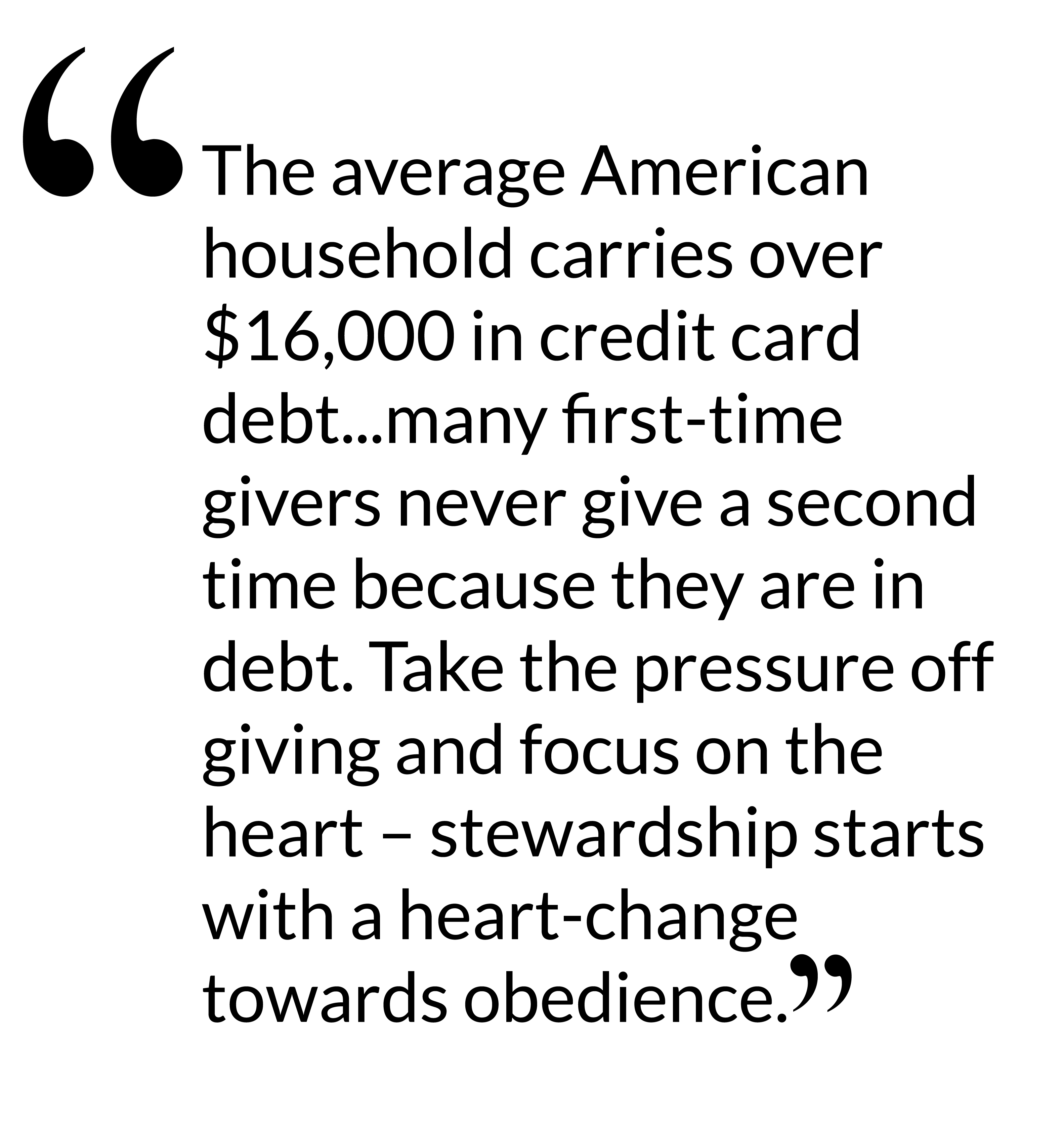If you’re like most churches, your first-time giver retention rate is substantially lower than any other giver in your church. In fact, the average giver retention rate in 2016 was 45 percent—a -0.5 percent change from 2015’s rate. And over the last 10 years, giver and gift (or dollar) retention rates have consistently been weak – averaging below 50 percent. (1)
How do we reach and transition these first-time givers into financial leaders? Here are some basic steps to help you increase retention and conversion of your attendees.
1. Tie Your Giving to the Cause – Studies show that if you tie the reason for giving to a specific campaign or cause, your chances of reaching and retaining first-time donors increases substantially.
Here are some simple ideas to help you achieve this type of reach:
a. Video messaging: Have your video team create a video of a specific ministry or life that is being changed by your church’s giving. The emotional tie to the actual life-change will help people see the cause and effect of their giving.
b. Bulletin Insert: Write up a short article about how your church is furthering the Gospel through the life-changing donations of your givers.
c. Drip Email Marketing Campaign: Create a 4-week email campaign directed at first-time givers and people who have stopped giving. These emails can feature a short video or article about the causes your church is helping to fund. Don’t forget to have a link to your online giving portal at the end of each email.
2. Make Giving Easy – The reality today is that most people do not carry cash or checkbooks with them to church. To meet the ever-changing demand of this digital society, it is essential that you have a simple, easy-to-use online giving option.
We could write an entire blog (and we might do so later this year) on the various apps and tithe-based companies that can help you facilitate easier giving strategies. But the important thing to remember is that if you don’t already have an app or online giving strategy – it’s time to get one!
To make giving easier for your church attendees, make sure you’re following these online best practices:
- Online giving should take less than 2 minutes.
- Your online giving portal should be one of the first options on your website, allowing people to easily find and give.
- Refine your form so that only the most important information is obtained. Eliminate all non-essential questions. Reducing the number of form fields to 4 or essential questions. Reducing the number of form fields to 4 or the number of form fields to 4 or fewer increases conversions by 160 percent.(2) You can collect additional information during follow-up emails.
- Take a few minutes and walk through your online giving platform as a guest and take notes on the places that it could and should be easier to give.

3. Take the Pressure Off – According to the US Census Bureau, the average American household carries over $16,000 in credit card debt.(3) If this statistic rings true for churches, many first-time givers never give a second time because they are in debt. Let’s take the pressure off giving and instead put the focus on the heart. Stewardship starts with a heart-change towards obedience, so we need to focus on the idea of giving and not the amount.
Here are some practical steps to help people start giving:
- No number is too low – encourage your attendees to consistently give an amount they are comfortable with. Don’t start at 10 percent. Ask them to consider giving $30 a month or approximately $1 a day.
- Encourage your givers with immediate appreciation. Directly after a first-time gift, some type of thank you should be sent, appreciating them for their gift.
- Setup a communication strategy for appreciating your first-time givers and don’t forget to include the ‘cause’ their gifts are supporting.
4. Track Your Givers – No Matter the Size of the Gift – Recently, The Chronicle of Philanthropy published an article noting that charities are working harder at getting donors to give again. Retention rate, or keeping a donor donating, is a huge concern for non-profits. They work extra hard at attempting to garner additional gifts throughout the year, and they track all of their donors. One major problem for churches is that we fail to track our donors.
No matter the size of the gift, it’s important to track your donor. MortarStone works with your Church Management Software (ChMS) to help you better track, analyze, and know your givers; providing you detailed reports and analytics to reach different givers within your congregation.
Get more information about MortarStone here – we’d love to show you how easy it is to manage your givers.
5. Acknowledge Gifts (of any size)
Gratitude is good for the brain. Dr. Christian Jarrett, in the Science of Us, talked about a brain-scanning study published in NeuroImage, “which brings us a little closer to understanding why these [gratitude] exercises have these effects. The results suggest that even months after a simple, short, gratitude-writing task, people’s brains are still wired to feel extra thankful.”
Here are a few ways to say, “thank you” to your givers:
- Handwritten notes: When possible, try to send a personalized, hand-written note to your givers. If the note can be signed by your senior pastor, that’s even better.
- Online email automation: After a donation has been given online, you should schedule to have an automatic email sent thanking the giver for their tithe.
- Text thank you: If a donation is made through an app, the giver should also receive an automated thank you from your app via text.
- Say “thank you” from the pulpit: Remind your senior pastor to regularly thank givers as a whole from the pulpit. Regular, encouraging acknowledgments show appreciation and increase generosity in your church.
